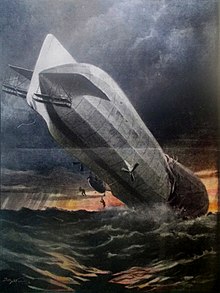Helgoland Island air disaster
The Helgoland Island air disaster occurred on 9 September 1913 after the airship Zeppelin LZ 14 had been transferred to the Imperial German Navy on 7 October 1912. As the first airship owned by the Navy, it was given the serial number L-1. Ordered to participate in manoeuvers, it departed the mainland in bad weather. With 20 people on board, L-1 flew into a gale, and, while 18 miles from its destination, the cold rain caused its gas to contract, causing it to settle 32 km; 17 nmi (20 mi) north of Heligoland into the North Sea, breaking in two. The control car sank, drowning 13 of its occupants. Seven were rescued by motor torpedo boats.[1] [2] [3]
 | |
| Accident | |
|---|---|
| Date | 9 September 1913 |
| Summary | Weather |
| Site | North Sea, off Heligoland |
| Aircraft | |
| Aircraft type | Airship |
| Aircraft name | LZ14 (manufacturer's designation) |
| Operator | Imperial German Navy |
| Registration | L 1 (military designation) |
| Crew | 20 |
| Fatalities | 14 |
| Survivors | 6 |
References
- George Edward Plumbe; James Langland; Claude Othello Pike (1913). Chicago Daily News Almanac and Year Book. Chicago Daily News, Incorporated. p. 396.
- The New York Times, September 10, 1913, p. 1.
- The New York Times, September 14, 1913, p. 3.
- "Airship Loss Fails to Daunt Germans". The New York Times. New York, NY: Adolph Ochs. September 10, 1913. ISSN 1553-8095. OCLC 164552. Retrieved June 26, 2020.
- "German Airship Lost with 15 Men". The New York Times. New York, NY: Adolph Ochs. September 14, 1913. ISSN 1553-8095. OCLC 164552. Retrieved June 26, 2020.
This article is issued from Wikipedia. The text is licensed under Creative Commons - Attribution - Sharealike. Additional terms may apply for the media files.